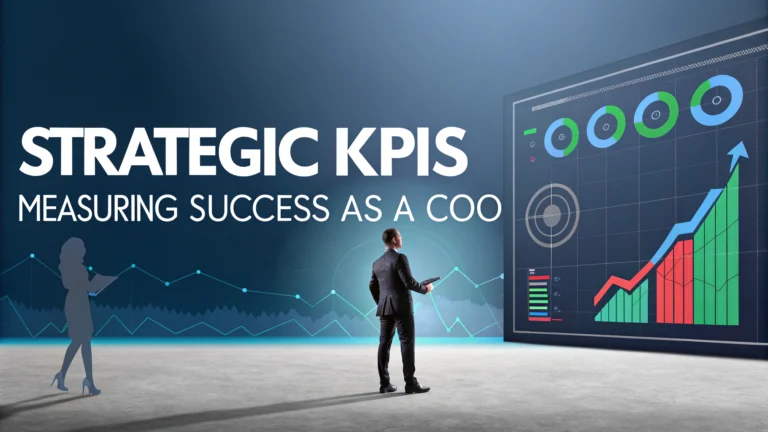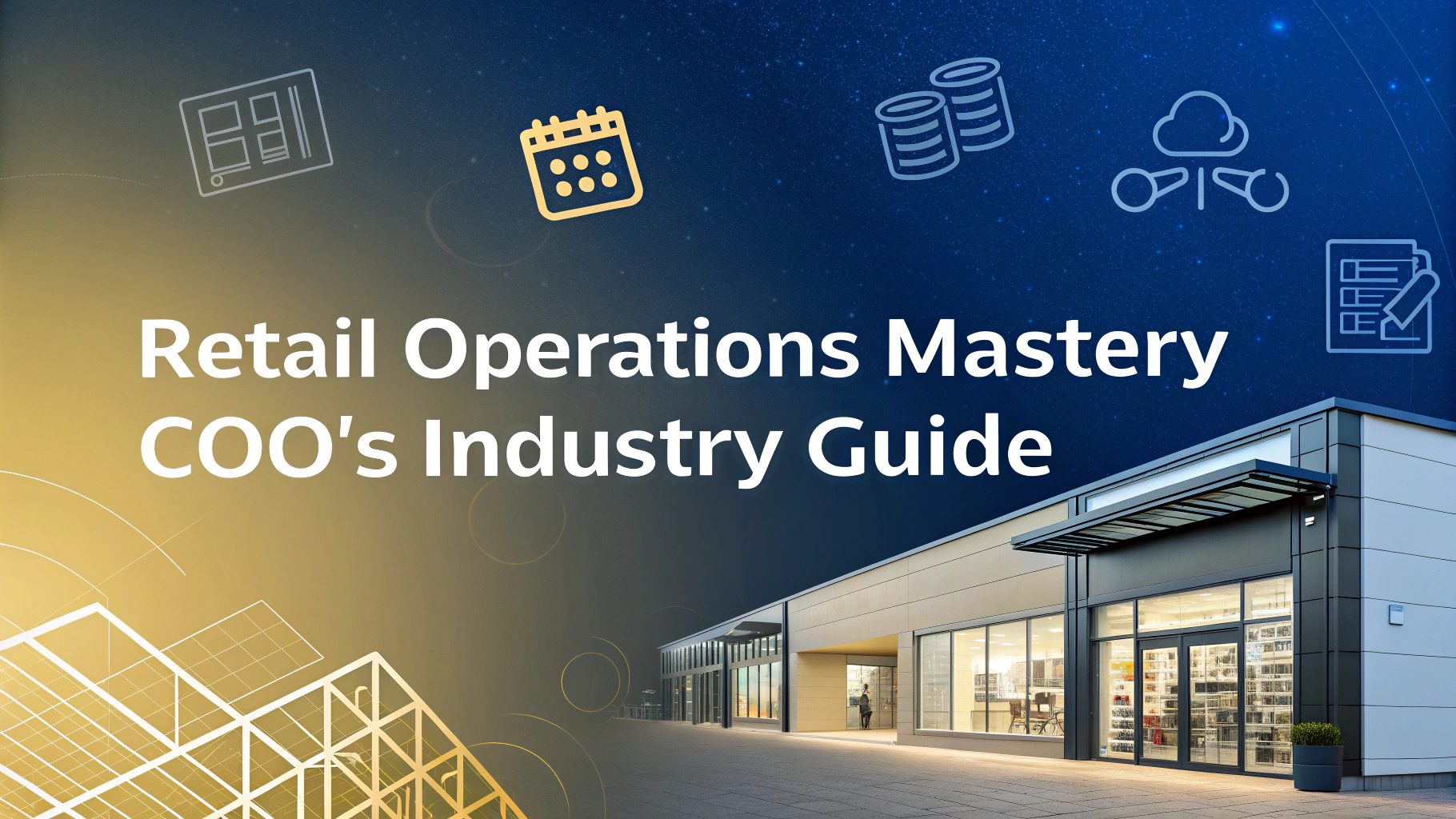A Chief Operating Officer’s success hinges on their ability to track and optimize the right performance metrics.
Strategic KPIs help COOs make data-driven decisions that align with company objectives and drive operational excellence.
This guide outlines the essential KPIs that modern COOs should monitor to measure and improve organizational performance.
Financial Performance Metrics
- Operating Margin: Net operating income divided by revenue
- Cash Flow: Net amount of cash moving in and out of the business
- Revenue Growth Rate: Percentage increase in revenue over time
- Cost per Unit: Total production costs divided by units produced
Operational Efficiency KPIs
- Capacity Utilization: Actual output compared to potential output
- Cycle Time: Time from start to completion of a process
- Inventory Turnover: How quickly inventory is sold and replaced
- Employee Productivity: Output per employee hour worked
Customer-Centric Metrics
- Customer Satisfaction Score (CSAT): Direct feedback from customers
- Net Promoter Score (NPS): Customer likelihood to recommend
- Customer Retention Rate: Percentage of customers retained over time
- First Response Time: Speed of initial customer service response
Quality and Compliance Metrics
- Defect Rate: Number of defective units per total production
- Compliance Rate: Adherence to regulatory requirements
- Safety Incidents: Number of workplace accidents or near-misses
- Quality Audit Scores: Results from quality control inspections
Employee Performance Indicators
- Employee Turnover Rate: Percentage of employees leaving annually
- Training Completion Rate: Percentage of completed required training
- Employee Engagement Score: Measured through surveys and feedback
- Time to Fill Positions: Average days to fill vacant roles
Supply Chain Metrics
- On-Time Delivery Rate: Percentage of orders delivered on schedule
- Supplier Quality Rating: Performance score of suppliers
- Order Accuracy: Percentage of orders filled correctly
- Supply Chain Costs: Total costs associated with supply chain operations
Innovation and Growth Metrics
- New Product Success Rate: Percentage of successful product launches
- R&D Return on Investment: Return generated from R&D spending
- Time to Market: Duration from concept to product launch
- Innovation Pipeline Value: Projected value of new initiatives
Setting Up Your KPI Dashboard
Select 5-7 core KPIs that align with your organization’s strategic goals.
Implement a reliable data collection and reporting system to track these metrics.
Review KPIs monthly with department heads to identify trends and areas for improvement.
Set realistic targets for each KPI based on industry benchmarks and company capabilities.
Taking Action on KPI Insights
Create action plans to address underperforming metrics.
Communicate KPI goals and progress regularly to all stakeholders.
Adjust strategies based on KPI trends and feedback from team leaders.
Document successful interventions to build a playbook for future improvements.
Moving Forward with Strategic Metrics
Regular review and refinement of KPIs ensure they remain relevant to business objectives.
Consider using specialized KPI tracking software to automate data collection and analysis.
Connect with industry peers through professional networks like COO Alliance to benchmark and share best practices.
Adapting KPIs for Different Industries
Manufacturing
- Equipment Effectiveness: Overall equipment efficiency rate
- Production Line Yield: Percentage of acceptable units
- Energy Consumption: Cost per unit of production
Service Industries
- Utilization Rate: Billable hours versus total hours
- Client Satisfaction: Project completion feedback
- Service Level Agreements: Percentage of met commitments
Technology Integration for KPI Tracking
Implement real-time dashboards for immediate performance visibility.
Utilize predictive analytics to forecast KPI trends and potential issues.
Integrate IoT sensors for automated data collection in operations.
Building a Performance-Driven Culture
- Regular Performance Reviews: Monthly assessment of KPI achievements
- Employee Recognition: Rewards for meeting KPI targets
- Transparent Communication: Clear sharing of metrics across teams
- Continuous Improvement: Regular feedback loops for KPI refinement
Driving Sustainable Success Through Metrics
Successful KPI management requires continuous evolution and adaptation to changing business needs.
Balance short-term performance metrics with long-term strategic indicators.
Empower teams with the tools and training needed to impact their relevant KPIs.
Remember that metrics should guide decision-making but not replace sound business judgment.
FAQs
- What are the most critical KPIs a COO should monitor?
A COO should monitor operational efficiency metrics, customer satisfaction scores, employee productivity rates, cost optimization metrics, quality control measurements, supply chain performance, revenue per employee, and operational risk indicators. - How often should a COO review strategic KPIs?
Strategic KPIs should be reviewed on multiple timelines: daily for critical operational metrics, weekly for team performance, monthly for financial indicators, and quarterly for long-term strategic goals and market positioning. - What financial KPIs are essential for a COO to track?
Essential financial KPIs include operating margin, cash flow efficiency, cost per unit, return on invested capital (ROIC), working capital ratio, inventory turnover, and operational expense ratios. - How can a COO effectively measure employee productivity?
Employee productivity can be measured through output per hour, revenue per employee, absenteeism rates, overtime hours, project completion rates, and quality metrics relative to time invested. - What customer-centric KPIs should a COO focus on?
Key customer-centric KPIs include Net Promoter Score (NPS), customer satisfaction index, customer retention rate, service level agreement compliance, response time metrics, and customer complaint resolution time. - How should a COO align operational KPIs with company strategy?
COOs should ensure KPIs directly support corporate objectives, cascade down through departments, align with strategic initiatives, and reflect both short-term operational efficiency and long-term strategic goals. - What supply chain KPIs are crucial for operational success?
Critical supply chain KPIs include inventory accuracy, supplier delivery performance, order fulfillment rate, procurement cycle time, warehouse efficiency metrics, and supply chain cost as a percentage of revenue. - How can a COO measure operational risk effectively?
Operational risk can be measured through compliance rates, incident frequency rates, system downtime, error rates, safety incidents, audit findings, and risk mitigation effectiveness metrics. - What quality control KPIs should a COO monitor?
Essential quality control KPIs include defect rates, first-pass yield, equipment effectiveness, process capability indices, quality costs, and customer complaint rates related to quality issues. - How should a COO measure innovation and process improvement?
Innovation and process improvement can be measured through new process implementation rates, cost savings from improvements, cycle time reductions, employee suggestion implementation rates, and return on innovation investments.








